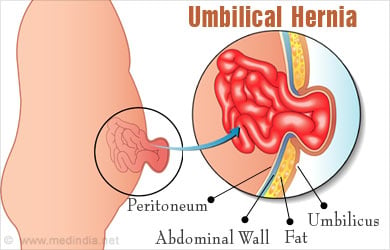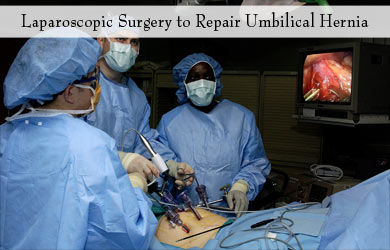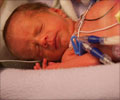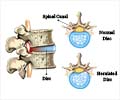What is Umbilical Hernia?
Umbilical hernia is a type of an abdominal hernia that can affect men, women and children.
Our body cavities like the thorax and abdomen have an inner lining, which is supported by the outer muscle layer. Sometimes, there is a weak point in the muscle. Activities that increase pressure within the cavity like lifting heavy weights can cause the inner lining to bulge out through the weak spot, resulting in a hernia. Though a hernia is usually painless, a large hernia can twist on itself. If some organ like the bowel has slipped into the hernia, its blood supply can get cut off, resulting in grave consequences.

Umbilical hernia is a type of an abdominal hernia that arises at or around the umbilicus or belly button. There are several causes of umbilical hernia. Umbilical hernias may arise due to a birth defect, or may occur in babies due to an infection of the umbilical region. In adults, umbilical hernia is commonly due to obesity or fluid accumulation in the abdomen. Women may develop umbilical hernia after repeated pregnancies.
What is the Treatment for Umbilical Hernia?
Umbilical hernias in babies usually resolve by the age of 4-5 years and therefore, do not always require surgery. Surgical treatment is required if the hernia does not resolve as the child grows. Umbilical hernias in adults should be repaired, even if they have not developed complications since they have the potential to do so.
Are any Tests Required Before Umbilical Hernia Surgery?
You will be advised routine tests like blood and urine tests, ECG, etc. that are usually done before any surgery. An ultrasound may also be advised.

It is also necessary to correct the cause of the hernia before surgery so that the condition does not recur. If the hernia is due to excess fluid in the abdomen, the fluid should be removed and its cause should be treated. An obese patient should be put on a weight-loss program before the surgery.
How is Surgery for Umbilical Hernia Done?
Surgery for umbilical hernia can be done through open access or a laparoscope. The procedure is done under general, local or spinal anesthesia.
In an open umbilical hernia repair procedure, an incision is made on the skin usually below the umbilicus. The contents of the sac are reduced and the hernia sac is removed. Following this, the defect has to be closed. This is achieved using two methods:
- For small umbilical hernias, the defect is closed with non-absorbable sutures. This process is called herniorrhaphy.
- In some cases, a mesh is placed over the weak spot to strengthen it and prevent recurrence of the hernia. The hernia repair procedure where a mesh is used is called hernioplasty.
Surgical meshes used in hernia repair may be synthetic or derived from animals. Synthetic meshes may be absorbable or non-absorbable. Animal-derived meshes may be derived from pig or cow tissue, and they are absorbed in due course. However, they give time for the tissue to grow back and regain strength to the repaired area.
Laparoscopic or keyhole surgery is a procedure where surgery is carried out through small holes in the abdomen. During the procedure, air or carbon dioxide is introduced into the abdomen to increase visibility. A telescope with a camera at the end is introduced through one opening while instruments to carry out the surgery are introduced through other openings. Both herniorrhaphy and hernioplasty can be carried out using this procedure.

Laparoscopic surgery is preferred to open surgery for umbilical hernia repair since:
- Hospital stay is shorter
- Complications are less
- Chances of recurrence are less
- Scarring is less
What are the Complications Associated with Umbilical Hernia Repair?
Complications of umbilical hernia include the following:
- Excessive bleeding
- Trauma to the bowel or bladder
- Infection at the site of the surgery
- Accumulation of fluid at the site of repair, which may resolve on its own or require aspiration
- Prolonged pain
- Respiratory tract infection
- Risks associated with anesthesia especially when general anesthesia is used
- Recurrence of the hernia
 MEDINDIA
MEDINDIA
 Email
Email





